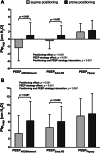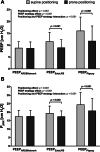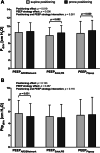Effects of different positive end-expiratory pressure titration strategies during prone positioning in patients with acute respiratory distress syndrome: a prospective interventional study
- PMID: 35346325
- PMCID: PMC8962042
- DOI: 10.1186/s13054-022-03956-8
Effects of different positive end-expiratory pressure titration strategies during prone positioning in patients with acute respiratory distress syndrome: a prospective interventional study
Abstract
Background: Prone positioning in combination with the application of low tidal volume and adequate positive end-expiratory pressure (PEEP) improves survival in patients with moderate to severe acute respiratory distress syndrome (ARDS). However, the effects of PEEP on end-expiratory transpulmonary pressure (Ptpexp) during prone positioning require clarification. For this purpose, the effects of three different PEEP titration strategies on Ptpexp, respiratory mechanics, mechanical power, gas exchange, and hemodynamics were evaluated comparing supine and prone positioning.
Methods: In forty consecutive patients with moderate to severe ARDS protective ventilation with PEEP titrated according to three different titration strategies was evaluated during supine and prone positioning: (A) ARDS Network recommendations (PEEPARDSNetwork), (B) the lowest static elastance of the respiratory system (PEEPEstat,RS), and (C) targeting a positive Ptpexp (PEEPPtpexp). The primary endpoint was to analyze whether Ptpexp differed significantly according to PEEP titration strategy during supine and prone positioning.
Results: Ptpexp increased progressively with prone positioning compared with supine positioning as well as with PEEPEstat,RS and PEEPPtpexp compared with PEEPARDSNetwork (positioning effect p < 0.001, PEEP strategy effect p < 0.001). PEEP was lower during prone positioning with PEEPEstat,RS and PEEPPtpexp (positioning effect p < 0.001, PEEP strategy effect p < 0.001). During supine positioning, mechanical power increased progressively with PEEPEstat,RS and PEEPPtpexp compared with PEEPARDSNetwork, and prone positioning attenuated this effect (positioning effect p < 0.001, PEEP strategy effect p < 0.001). Prone compared with supine positioning significantly improved oxygenation (positioning effect p < 0.001, PEEP strategy effect p < 0.001) while hemodynamics remained stable in both positions.
Conclusions: Prone positioning increased transpulmonary pressures while improving oxygenation and hemodynamics in patients with moderate to severe ARDS when PEEP was titrated according to the ARDS Network lower PEEP table. This PEEP titration strategy minimized parameters associated with ventilator-induced lung injury induction, such as transpulmonary driving pressure and mechanical power. We propose that a lower PEEP strategy (PEEPARDSNetwork) in combination with prone positioning may be part of a lung protective ventilation strategy in patients with moderate to severe ARDS.
Trial registration: German Clinical Trials Register ( DRKS00017449 ). Registered June 27, 2019. https://www.drks.de/drks_web/navigate.do?navigationId=trial.HTML&TRIAL_ID=DRKS00017449.
Keywords: Acute respiratory distress syndrome; Lung protective ventilation; Positive end-expiratory pressure; Prone position; Respiratory mechanics; Transpulmonary pressure; Ventilator-induced lung injury.
© 2022. The Author(s).
Conflict of interest statement
The authors declare that they have no competing interests.
Figures




References
-
- Serpa Neto A, Deliberato RO, Johnson AEW, Bos LD, Amorim P, Pereira SM, et al. Mechanical power of ventilation is associated with mortality in critically ill patients: an analysis of patients in two observational cohorts. Intensive Care Med. 2018;44(11):1914–1922. - PubMed
-
- Gattinoni L, Carlesso E, Brazzi L, Caironi P. Positive end-expiratory pressure. Curr Opin Crit Care. 2010;16(1):39–44. - PubMed
Publication types
MeSH terms
LinkOut - more resources
Full Text Sources

